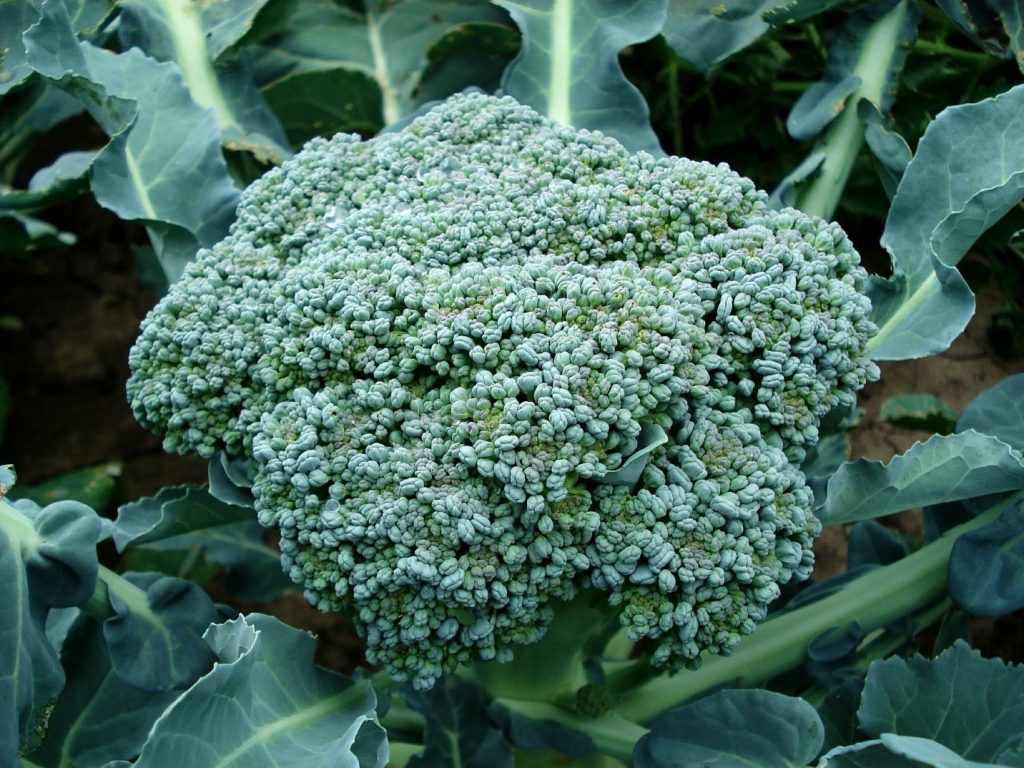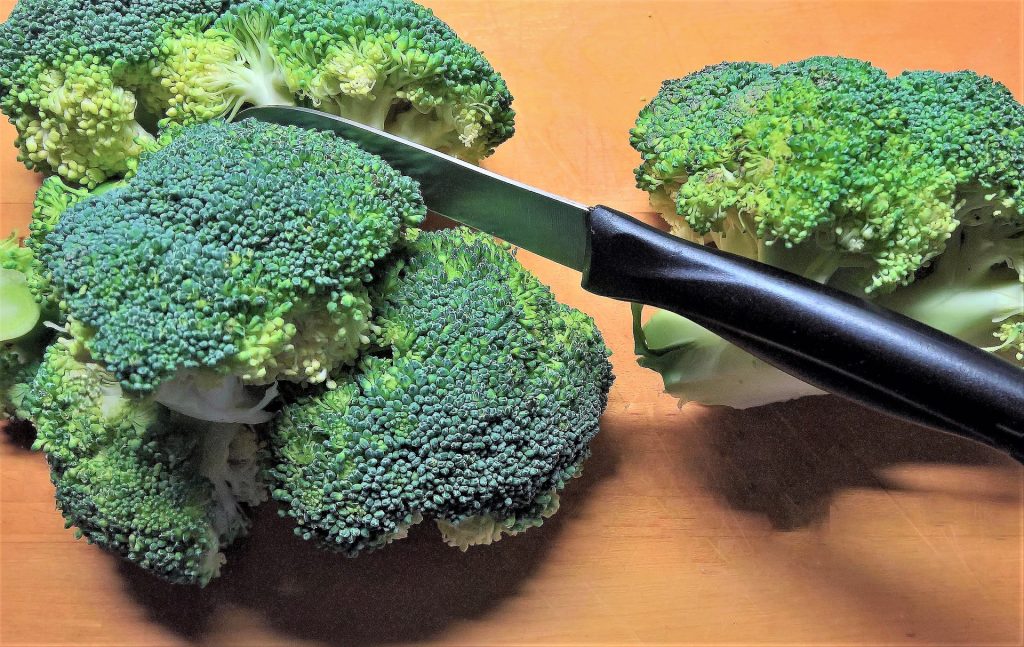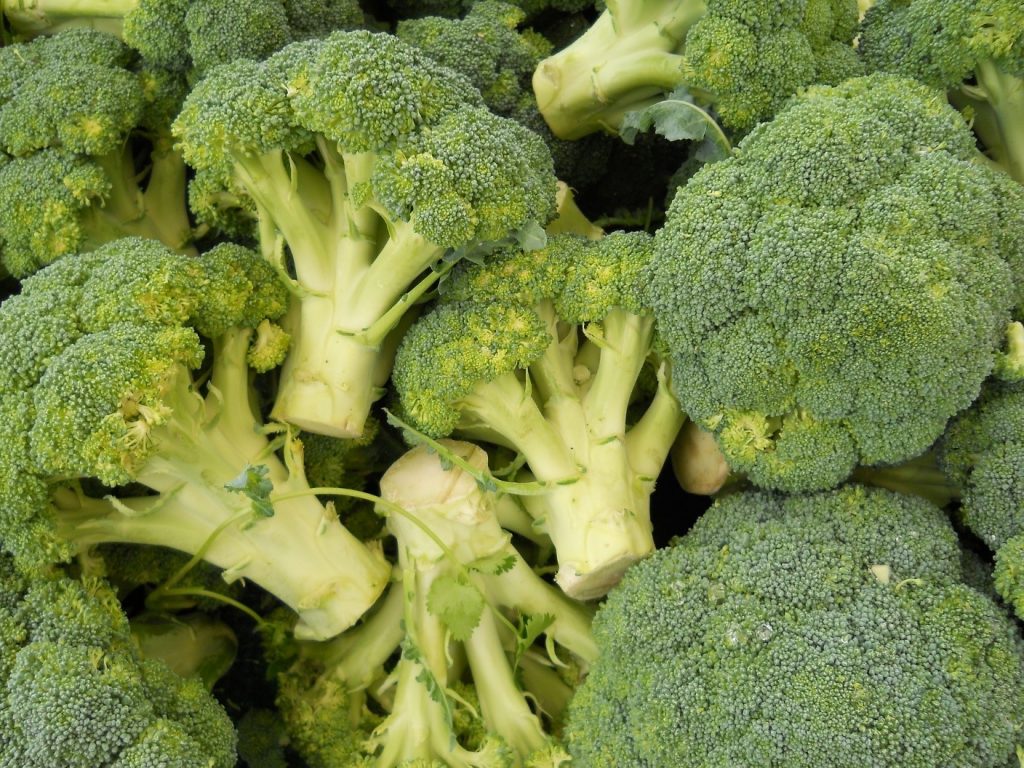Broccoli has been cultivated for 2,000 years and may have evolved from wild cabbage on the continent of Europe. Broccoli is a cool season vegetable crop that can yield over an extended period of time if properly grown and harvested. Like most fresh produce from the Brassicaceae family, broccoli florets are rich in vitamin C and a good source of vitamin A, B6, and folate. Broccoli is also good source of fiber and provides small amounts of calcium and iron.

Helpful Hints!
- Soaking fresh-grown broccoli in salt water for 5-10 minutes can help remove unwanted pests.
- Broccoli can come in a variety of colors: green (Calabrese), yellow-green (Romanesco), and even purple, depending on the variety!
Seasonality
As a cool season vegetable, two crops of broccoli per year (spring and fall) may be grown in most parts of the country, including Colorado. New heat tolerant varieties allow broccoli to be produced in all but the hottest parts of the season. Transplants are recommended to give the best start for spring planting. Fall crops may be direct-seeded in the garden if space allows or may be started in flats to replace early crops when their harvest ends. The edible parts of broccoli are compact clusters of unopened flower buds and the attached portion of stem. The green buds develop first in one large central head and later in several smaller side shoots. Once the buds begin to form, the harvest of broccoli can last for several weeks.
Safe Storage and Handling

Broccoli should be stored unwashed, in loose perforated bags in the refrigerator. Broccoli left unrefrigerated will quickly become woody and fibrous. Wet broccoli can become limp and soggy as well as support the growth of microorganisms, so wait to rinse until just before eating.
Broccoli can be safely kept in the refrigerator for 3-5 days. The highest nutritional value and best flavor will result when storage time is kept short. Broccoli florets have a rough, complex surface that can harbor and support the growth of illness-causing bacteria. Use fresh, cold water to rinse broccoli before cooking and always reheat cooked broccoli before consumption.
Cooking
Broccoli can be enjoyed raw or cooked. Steaming broccoli for 3-4 minutes is the preferred method of cooking, as it results in the greatest retention of flavor and nutrients. Short time microwaving with little or no water also helps retain nutrients and flavor. Boiling results in the greatest nutrient losses. Cooked broccoli should be bright green and tender-crisp. Overcooked broccoli develops a strong sulfur odor, turns dark green and suffers nutrient loss, especially vitamin C.

Home Preservation
Freezing is the best method for preserving broccoli. Select broccoli in peak condition for eating and prepare it for freezing as soon after harvesting as possible. It’s important to blanch broccoli in steam or boiling water prior to freezing. Unblanched vegetables contain an active enzyme which can cause broccoli to toughen over time. Blanching stops this enzyme activity and preserves the flavor and nutrient content of the broccoli during storage.
Blanching and Freezing Steps
- Select tender, dark green stalks. Wash well.
- To remove insects from heads, soak for 5-10 minutes in salt water (4 tsp salt/gal water). Rinse and drain.
- Cut broccoli into pieces not more than 11/2 inches across. Trim stalks.
- In a large pot with a tight fitting lid, bring 5 quarts of water to a rolling boil.
- Prepare an ice bath in a 5 quart container.
- Blanch in steam for 6 minutes or in boiling water for 4 minutes.
- Remove broccoli with a slotted spoon or basket.
- Submerge blanched broccoli in an ice bath for 5 minutes, or until cooled. Pat dry.
- Pack cold broccoli into freezer containers or bags and squeeze out as much air as possible before sealing the container.
- Label and date each container. Blanched and frozen broccoli can keep in the freezer for up to one year at 0°F or below.

Why is my broccoli so tough and chewy?
At room temperature, harvested broccoli converts sugars into a fiber called lignin. The more time spent at room temperature, the more lignin is produced and the more fibrous your broccoli becomes! Keep broccoli refrigerated to extend the shelf life.
| Quality Note: Broccoli is extremely sensitive to ethylene. Florets will turn yellow if exposed to high amounts. Make sure it is stored away from fruit or vegetables that produce high amounts of ethylene such as bananas, apples, or peaches. |
Broccoli Cheddar Soup
- 1 large head of broccoli (12 ounces or 3/4 lb.), cut into small florets
- 2 tablespoons unsalted butter
- 1 shallot, chopped
- 1 medium onion, chopped
- 1 large potato, peeled and cut into 1/4-inch cubes
- 2 cloves garlic, finely chopped
- 3 1/2 cups vegetable broth
- 2/3 cup freshly grated aged Cheddar, plus more for topping
- 1-3 teaspoons whole grain mustard
Procedure: Melt the butter (or olive oil) in a large saucepan over medium-high heat. Stir in the shallots, onion, and a big pinch of salt. Sauté for a few minutes. Stir in the potatoes, cover, and cook for about four minutes, just long enough for them to soften up a bit. Uncover, stir in the garlic, then the broth. Bring to a boil, taste to make sure the potatoes are tender, then stir in the broccoli. Simmer just long enough for the broccoli to get tender throughout, about 2 – 4 minutes.
Immediately remove the soup from heat and puree with an immersion blender. Add half the cheddar cheese and the mustard (a little bit at a time). Now add more water or broth if you feel the need to thin out the soup. Taste and add more salt if needed.
Related Links


